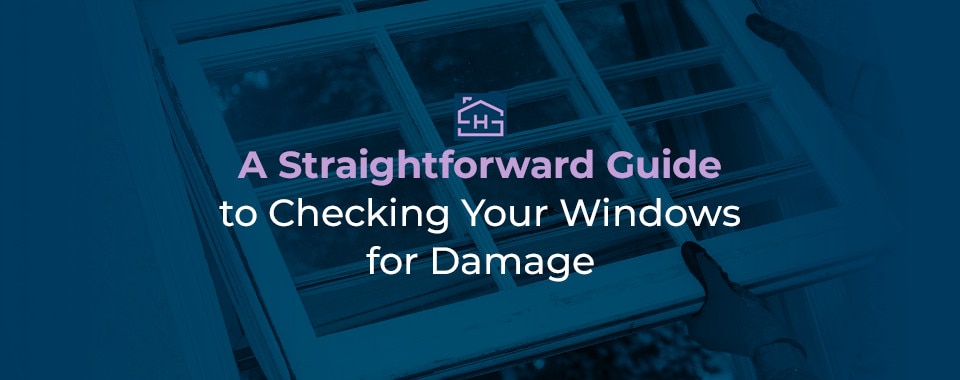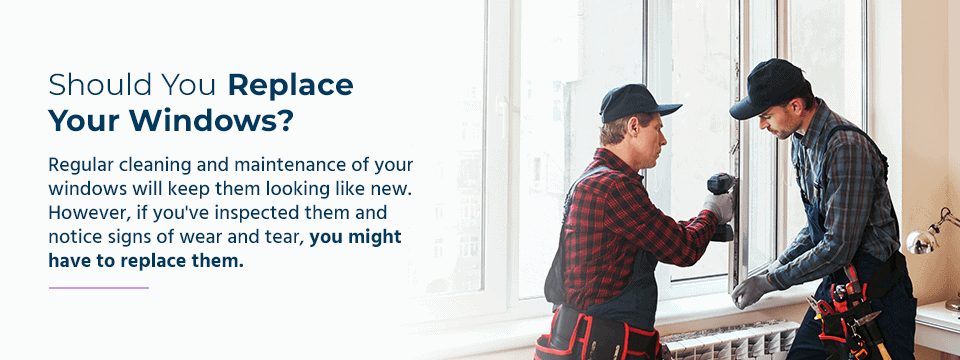High-quality windows can enhance your home’s curb appeal and bring natural light into your living space. Over a few decades, these components may suffer damage from wear and tear and unpleasant weather conditions. Any cracks in your glass or frames could let in unwanted moisture and drafts from the outside. Use this guide to learn how to know if your windows need replacing.
How to Check Your Windows for Damage
Follow this checklist as you walk around the house and examine your windows:
- Inspect the inside and outside of each window: Look closely at the interior and exterior of your windows for stains, rust, and cracks. Examine the glass and the frame, and look at the ceilings, walls, floors, and sills around them for discoloration from moisture leaks. If you see any damage, you should have the faulty components replaced.
- Check your window operation: Try opening and closing your windows to see how well they glide along the tracks. Sometimes sand, dirt, and debris can get stuck on the pathway, but if you have to force the sash open or closed, you probably need to replace it.
- Test locks and latches: Locks and latches secure the window, so if they’re not in working order, you risk someone breaking into your house. Twist these components to test their security, and repair or replace them if they’re stuck or low quality.
- Look for water damage: Wooden frames can rot or warp when exposed to moisture. Inspect for discoloration, spots, peeling paint, and warped pieces of wood. If you notice any of these signs of moisture damage, find the root of the issue, like a leaky roof or broken window frame, and repair or replace the window.
- Check for dirt: Open your windows and check the tracks and around the frame for debris and dirt. These small contaminants can get in the way of the seal and prevent smooth operation. Clean your windows if you have grime around them, but replace them if mold has developed.
- Check weatherstripping and caulk: Tight seals and weatherstripping improve the energy efficiency of your windows by keeping out drafts and cold air. Examine the openings around them and replace any portions that are ripped or torn.
- Keep an eye on condensation: You know if your window seal is broken if you notice foggy windows. Even though you might occasionally see some condensation on the glass, you’ll need to replace them if there’s moisture between the two glass panes.
- Review energy bills: If you notice your energy bills increasing over a few months, your windows might be letting in drafts. When outdoor air is coming into your home, your HVAC system must work harder to regulate the indoor air temperature. Replacing your windows can help reduce your monthly utility expenses.
- Inspect weep holes: The small holes on the bottom of your window frame drain water away from the sill. It helps to clean the weep holes so the frame doesn’t rot or grow mold. If you clean blockages out of these holes, you can prevent damage before they become challenging to repair.
Should You Replace Your Windows?
Regular cleaning and maintenance of your windows will keep them looking like new. However, if you’ve inspected them and notice signs of wear and tear, you might have to replace them. Even if you don’t get replacements installed, you could repair faulty parts to enhance the lifespan of your windows.
You could repair your windows if you discover:
- Appearance defects: You can easily apply a new color over chipped or faded paint. Before painting, repair any holes or cracks that you notice on the frame. If the discoloration is from sun or water damage, you would have to replace the window.
- Dirty glass: To clean dirt off the panes, use a glass cleaner or hire a professional cleaning company. However, you would have to get the window replaced if you have dirt between panes.
- Minor hardware problems: If your window doesn’t open or close properly, there might be dirt in the tracks or issues with the locks and latches. Check with the manufacturer about replacing faulty parts instead of installing a replacement product.
On the other hand, you would need to replace your windows if you find:
- Condensation between window panes: Cloudiness or condensation between glass panes means that the seal failed and has allowed dirt and moisture inside. Since your window won’t be as energy efficient with broken seals, you would likely save money on utility bills and enhance your curb appeal if you have it replaced.
- Warped window frame: If you repaired or cleaned the hardware, but you’re still having trouble opening the window, the wooden frame might have become warped from weather or moisture damage.
- Windows not opening or closing correctly: Faulty operation of your window could become a safety hazard because it could let pests and intruders into your home. If it doesn’t open or close properly, you’ll have to replace it.
How Much Will It Cost to Replace Your Windows?
Windows vary in price, so you won’t know what you’ll pay until you schedule an estimate. Homespire Windows and Doors offers free window analyses to provide you with an exact cost to replace your windows. The cost depends on these factors:
- Type: Whether you get a double-hung or picture, the type of window affects the price. It helps to replace it with a similar one, but you might have to pay more money to upgrade to a different style.
- Energy efficiency: When you invest in energy-efficient windows, you’ll have to pay more money upfront. Keep in mind that no matter what the project costs, you can save up to 35% on your energy bill with energy-efficient glass.
- Size: Bigger windows cost more money because they require more materials. If you change the size, you’ll have to pay more because the installer will need to cut into the wall to accommodate the new dimensions.
- Location in the house: If you need replacement windows on the second floor of your property, you might have to pay additional costs. Since the upper level is more difficult to access, the representative will need to use equipment to help them reach it.
- Age of house: An older home can add to your window installation price if you need custom products in nonstandard sizes to match your historical architecture. You’ll also need to update them so that they’re to code.
Let Homespire Replace Your Windows
At Homespire Windows and Doors, we provide quality customer service and attention to detail, using Made in the USA Certified products that last a lifetime. If you need replacement windows, browse through our products and contact us to schedule a free window analysis.
Get 20% Off
PLUS
No Deposit, No Payments, and No Interest for 12 Months*
*By completing the form, I consent to have Homespire Windows and its affiliates contact me to verify my information, schedule an appointment, or inform me of future product updates, which may include marketing. I consent to receive calls or texts that use automated technology or a pre-recorded voice at the phone number(s) provided. Consent is not required to receive goods and services. I can call the phone number found at the top of this web page. Please see our Terms & Conditions. Msg & data rates may apply.


